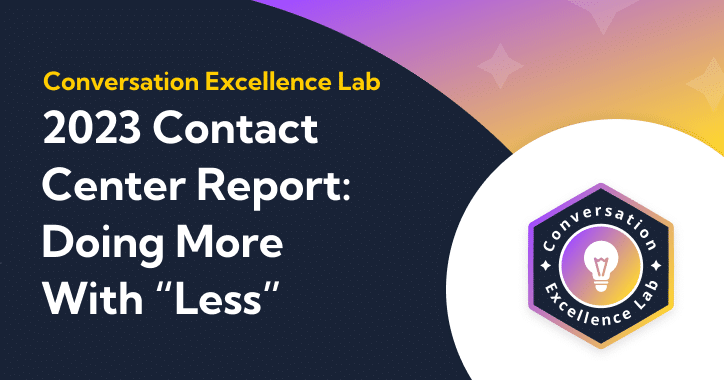Remote work is here to stay. Regardless of individual personal preference, the state of work has shifted in the last few years. Degrees of remote work can be expected at nearly all contact centers. We surveyed over 2,000 contact center employees about their thoughts on remote work, and their answers illuminated both what the remote work landscape is today, and what employees actually want it to be.
We dove into 6 of our favorite findings from our study below.
These findings are part of our series on agent attrition in today’s contact centers. Check out our full report here.
Subscribe to future Conversation Excellence Lab reports below:
1. Most contact center employees are working in person
Of the 2,000 contact center employees that we surveyed, 1,140 (55.29%) reported working fully in-person. The next most popular mode of work was hybrid (both in-person and virtually) at 527 respondents (25.56%). The 395 respondents who worked fully virtually made up 19.16% of our respondents.
Figure 1: Breakdown of Attrition Survey Respondents by Virtual, In-Person, and Hybrid Work
This may seem counterintuitive, but in reality, most employees have continued to work in-person throughout the pandemic. Virtual work rates reached their peak at 35% in May 2020. By March 2021 that figure was closer to 21%.
By this measure, the number of virtual workers in the contact center industry may seem high. In this industry, it makes sense that there may be more opportunities to conduct one’s job remotely. Of course, whether or not someone works in-person or remotely has to do entirely with the line of work they are in. There are variances even within the contact center industry. We’ll discuss this further in item #6.
2. Hybrid workers are the happiest…
Respondents who stated that they worked in a hybrid model — both virtually and in-person — also showed the highest levels of satisfaction across the board for pay, job advancement opportunities, and overall job enjoyment.
We measured these three dimensions using a Likert scale from 1 (Very Dissatisfied) to 7 (Very Satisfied). The average responses for satisfaction with pay, job advancement opportunities, and overall job enjoyment all fell within the 5-6 range (Somewhat satisfied - Satisfied). As shown below, hybrid workers had the highest average scores across all three dimensions.
Figure 2: Satisfaction with Pay, Satisfaction with Advancement, and Job Enjoyment by Work Type
They also made the most in both salary and hourly wage, while in-person employees made the least. Hybrid workers made about $8,000 more per year on average than in-person employees, or $2.25/hr more if they were hourly employees.
These findings may have to do with the nature of work that has to be conducted in-person, versus the type of work or position that allows one to work virtually or with a hybrid model. These positive outcomes may also be a result of choice: hybrid work — the ability to choose whether or when one works in-person or virtually — can be seen as a benefit by many, and lend itself to more desirable work environments. Those in higher-up positions within company hierarchies may have more access to benefits like hybrid work.
3. …And the most educated
Hybrid workers also displayed the highest levels of educational attainment. We codified educational attainment on a scale of 1 (Middle School or below) to 5 (Advanced Degree). Across the board, the average was 3.18, which was between a 2-year college degree and a 4-year college degree.
On average, hybrid workers had an educational attainment score of 3.55, compared to in-person employees at 3 and virtual employees at 3.14. These findings are not causal but, in fact, may point toward the nature of different jobs and their relative entry requirements. See finding #5 for a deeper dive into industry trends in remote work.
4. Women are less likely than men to be hybrid workers
Although women made up 53% of our survey, they made up 57% of our in-person workers and 58% of our virtual workers. Men, on the other hand, made up 47% of the survey but 60% of hybrid workers.
Figure 3: % of Men vs. Women in Virtual, Hybrid, and Remote Work
This discrepancy may have to do with many factors, including the industries in which men and women are more likely to work, gender preferences, life stage responsibilities, or education level and its relationship with work modality. We found that the women in our study, on average, saw lower educational attainment than men. Using the same codification as in the last section, we found that women had an average educational attainment of 2.99, with 2 representing a High School diploma and 3 representing a 2-year college degree. Men on the other hand had an average educational attainment of 3.38, between a 2-year degree and a 4-year degree.
5. Motivations vary between work modes…
When we asked employees what motivated them to join the contact center industry, their answers varied widely depending on whether their work was primarily in-person, virtual, or followed a hybrid model.
Those who worked fully in-person were most motivated by needing a job fast, and least motivated by pay. Those who worked remotely were similarly motivated by needing a job fast, but they were least motivated by learning a new skill.
Conversely, those who worked in a hybrid environment were most motivated by the prospect of joining a growing industry, and least motivated by needing a job fast.
This information suggests that there are innate differences, perhaps industry-related, between companies and jobs within the contact center industry that tend to be in-person, virtual, or hybrid. With these differences come differences in skill level, entry requirements, and other job aspects that may make them appealing to different types of people.
6. …And work modes vary by industry
Analyzing remote work trends on an industry level, we found that the industries most likely to be virtual were Insurance, Telecommunications & IT, and Collections. Those most likely to be in-person were Retail, Logistics, and Construction.
This makes logical sense: Some industries are in-person by their very nature, while others are often done from behind a desk. This finding, however, when considered in tandem with the previous ones on this list, can shed additional insight into differences in happiness, education, gender representation, and motivation when it comes to remote work.
In the chart below, we assigned in-person work a value of 1 and virtual work a value of 3. The industries most likely to work in-person are all the way on the left, and those most likely to work virtually are all the way on the right.
Figure 4: Likelihood of Working Virtually by Industry
Across the board, 74% of employees believe that remote work is the new status quo. 97% claim that they don’t want to return to an office full-time.
Conclusion
How should companies make decisions about the structure of their workforce? Employee preference should be regarded highly, as should the actual costs of keeping an in-person vs. virtual workforce. But there are other considerations to think about when deciding how to structure your workforce, and the findings highlighted here should serve as a jumping-off point for further exploration.
Click here to subscribe to future Conversation Excellence Lab reports.
Sources
Balto. (2022, March 29). Contact Center Attrition: What Agents Want in 2022 - Balto Ai. RSS. Retrieved February 8, 2022, from https://www.balto.ai/research/contact-center-attrition-2022/
Godfrey, E. (2021, September 20). Another Truth About Remote Work. The Atlantic. Retrieved February 8, 2022, from https://www.theatlantic.com/politics/archive/2021/09/work-from-home-numbers/620107/
Prossack, A. (2021, February 10). 5 Statistics Employers Need To Know About The Remote Workforce. Forbes. Retrieved February 8, 2022, from https://www.forbes.com/sites/ashiraprossack1/2021/02/10/5-statistics-employers-need-to-know-about-the-remote-workforce/?sh=6c86600d655d
Cite this report
Balto. (2022, February 8). In-Person or Virtual? 6 Surprising Findings About Remote Work at Contact Centers - Balto Ai. RSS. Retrieved from https://www.balto.ai/research/in-person-or-virtual/






